![]()
![]()
![]()
Use LEFT and RIGHT arrow keys to navigate between flashcards;
Use UP and DOWN arrow keys to flip the card;
H to show hint;
A reads text to speech;
31 Cards in this Set
- Front
- Back
- 3rd side (hint)
|
sarcopenia
|
loss of lean body mass due to age physical inactivity or fault y nutrition
|
age related
|
|
|
muscular strength
|
string muscles and bones increasing functional capacity prevent osteoporosis and type 2 diabetes
decrease risk of back pain and musculoskeletal injuries |
strong muscles help with optimal performance in adls house keeping recreational activities improving posture personal appearance and self image
|
|
|
muscular strength benefits
|
cardiovascular health Benefits of strength trainings are to reduce heart rate and blood pressure
. muscular strength and aging muscular strength contributes to independent living more than any other fitness component improves balance restore mobility make lifting and reaching easier decrease risk of injuries and falls |
when you stress the bone it preserve bone mineral density decreases the risk of osteoporosis
|
|
|
effects of steroids
|
.liver tumors mood swings
hepatitis aggressive behavior HTN increase irritability reduce hdl fluid retention hyperinsulism decrease libido impaired pituitary function hiv if use needle impaired thyroid function and prostate cancer in men |
detrimental damage
|
|
|
benefits of strength training
|
decrease in adipose tissue around muscle therfore you lose inches not so much body weight
|
Good benefits
|
|
|
muscular strength
|
ability to exert max forces against resistance it's measured in one repetition
|
to know how strong you are
|
|
|
muscular endurance
|
the ability of a muscle to exert sub maximal force repeatedly over time. measured in frequency.
|
how many reps can you do??
|
|
|
physiological factors to combine to create muscle contraction and later strength gains
|
neural simulation
type of muscle fiber overload specificity of training train volume periodization |
factors
|
|
|
muscle fiber types
|
the ratio of fast twitch to slow twitch muscle fiber is genetically determined, making them more suited to certain sports or activities.the ration of both fibers varies in each individual and each muscle
|
ratio of small twitch fiber is genetically determined
the metabolic capabilities of both types of fibers can improve through specific strength and endurance training |
|
|
slow twitch
|
muscle fibers with greater aerobic potential and slow speed contraction
during muscular contraction slow twitch fibers are always recruited first muscles that produce powerful rapid explosive strength movements tend to have a greater percentage of fast twitch fibers |
marathon runner
core stability/ posture |
|
|
fast twitch fibers
|
muscle fiber with great anaerobic potential and fast speed of contraction
important for quick and powerful movements and commonly use in strength training activities |
sprinters weigh lifters
|
|
|
overload principle
|
the training concepts that the demands laced on a system (cardio-respiratory or muscular) must be increased systematically and progressively over time to cause physiological adaptation development or improvement.
|
the more it becomes a regular the better over time
|
|
|
S specificity of training
|
Specificity of training even the principle that training must be done with the specific muscle a person is attempting to improve
|
Train the muscle you want to improve
|
|
|
Example of how overload can be used in strength training are
|
Increase the intensity the resistant are we used increase the number of reps at the current intensity increase or decrease the speed at which the reps are performed decrease the rest interval for endurance improvement with lighter resistance or lengthening the rest interval for strength and power development with higher resistance increase the volume the sum of Reps time the resistance use any combo of the above
|
Examples to improve muscle strength
|
|
|
Ot examples
|
Stroke patient exercise a large muscle groups that are deep self passive range of motion of shoulder flexion in supine with assistance from the on involved arm wrist fracture exercise the wrist muscle groups and any other related areas that are affected usually the forearm and hand may also be limited
|
|
|
|
Said specific adaptation to impose demands training
|
Said is the specific adaptation to impose demand in training training principle stating that for improvement occur in a specific activity the exercises performed during strength training should resemble as closely as possible the movement patterns encountered in that particular activity
|

OTA example bathroom transfers toilet transfers tub transfers repeated action to gain strength so that one increases their independence may also need bars tub chair or raised toilet seat
|
|
|
Training volume
|
It's the sum of repetitions performed multiplied by resistance use during a strength training session
|
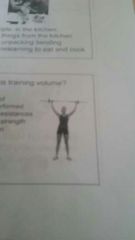
|
|
|
Train volume
|
Ot example. .pulley (shoulder exercise s no resistance 20 ( reps)×3
|
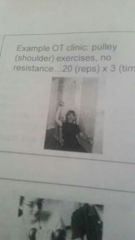
|
|
|
strenght training
|
Isometric training/ static
dynamic training /moving concentric /eccentric |
concentric shorting eccentric lengthing
|
|
|
Isometric training static
|
principles that training must be done with the specific muscle that the person is attempting to improve there is little to no movement
|
OTA example plank position pull wagon carry books arms are not moving
|
|
|
Dynamic training
|
The muscle contraction produces movement brent is gained through the full range of motion
|
Ot example extending the arm when using we are putting books on shelf
|
|
|
dynamic training consist of two action phases
|
Concentric are positive resistant phase the muscle shortens during a contracture. An example bicep shortens when you pick up a case and bring it to your mouth.
|
|
|
|
Eccentric
|
Negative resistance fate the muscle lengthens durina contraction this allows you to lower your arm or spoon in a smooth gradual and control manner
|
Negative resistance
|
|
|
Dynamic training can be done using
|
Free weights barbells for dumbbells machine fixed or variable resistant machine resistance the amount of weight lifted set fixed number of reps performed for a given exercise frequency number of times a week this is dependent upon the amount of assistance number of deaths per session and the person's ability to recover from the previous session
|
training
|
|
|
core strength training
|
a program designed to strengthen the abdominal, hip and spinal musculature
core of the body-- the muscle groups that are responsible for maintaining the stability of the spine and pelvis major muscle groups of the legs, shoulders and arms attach to the core. |
core contribute to better posture and balance
|
|
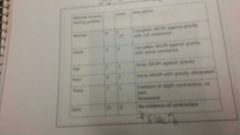
|
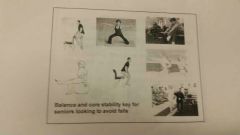
|
|
|
|
geriatric orthopedic and neurologic patient
|
need adaquate core to safely move and transfer to carry items to reach and do ADLs
|
may have to use walker or cane transfer bars and or benches seat
|
|
|
pediatric patients
|
needs adequate/ safe core foe posture seating transfers ambulation to propel a w/c to use walker to play to rachett the shoulder foundation for all fine motor tasks adls
|
low tone cp muscular dystrophy
|
|
|
manual muscle testing
|
. OT assess upper extremity strength and hand strength in adults via muscle testing
|
muscle groups flexor and extensor are resisted and given a grade
|
|
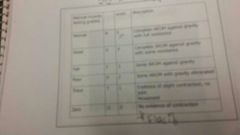
|
grade
|
|
|
|
evaluation for hand/finger
|
grip hand dynamometer and pinch pinch gauge
|
|

